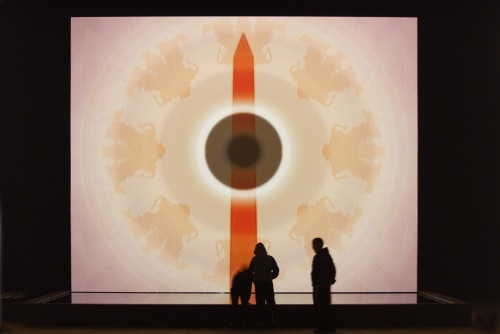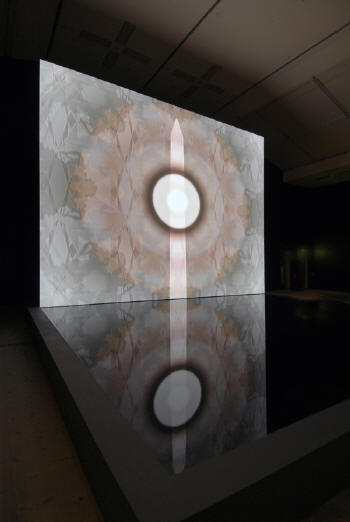Mark Titchner

My first encounter with Brion Gysin, like that of many others, came through reverence for the work of William Burroughs. Finding a copy of ‘The Job’ in the library at Central St Martins I was first exposed to an alternative history of averted potential, a time-line populated by the likes of Wilhelm Reich, Buckminster Fuller, L Ron Hubbard and at the tip of that arrow, Brion Gysin. Being the mid 90’s and thirty years since the book’s publication it was painfully obvious that the suppression and manipulation of such technologies and ideas had been as effective as Burroughs suggested it would be.
As a young artist trying to negotiate the idea of function in an art object I was fascinated by how these ideas were crystallised into objects, as Orgone Accumulators, Dymaxion Cars, E-Meters and Dreamachines. Whilst each object presented a vision of a future only the Dreamachine seemed still entirely viable as environmental pollution, multinational industry and religious dogma compromised the existence of the other devices.
As I discovered Genesis P-Orridge’s texts on Gysin in Re/Search and Rapid Eye it became clear that this was a very special person indeed. A fountain; the cut-up, permutation poetry, calligraphic paintings, novels, collage and sound experiments, too much for one person to achieve and plenty left for the rest of us to fill in.
 Despite
such an abundance of expertise it is the Dreamachine that is Brion
Gysin’s masterpiece. In collaboration with mathematician, Ian
Sommerville, he created an object that flies in the face of
commodity and utilises the greatest Readymade of them all, the
Human Brain. Somehow the duo managed to interpret W. Grey
Walter’s discoveries about the brains electrical activity into a
transcendental device that could be fabricated using simplest of
means. Self-Authored eyelid movies free for all, free forever.
Despite
such an abundance of expertise it is the Dreamachine that is Brion
Gysin’s masterpiece. In collaboration with mathematician, Ian
Sommerville, he created an object that flies in the face of
commodity and utilises the greatest Readymade of them all, the
Human Brain. Somehow the duo managed to interpret W. Grey
Walter’s discoveries about the brains electrical activity into a
transcendental device that could be fabricated using simplest of
means. Self-Authored eyelid movies free for all, free forever.
Perhaps it was once possible to imagine a future/present when every home would have a Dreamachine, around which the family would gather, leave their bodies and dream. Instead we have another kind of light we choose to gather around, a light show that we passively absorb and have little or no opportunity to influence. The act of creation is inverted to absorption.
Perhaps at the heart of this is the failure of the Dreamachine as a commodity, like Duchamp’s Rotoreliefs before them. Several attempts were unsuccessfully made to market the Dreamachine, there are many reasons for this failure but essentially the Dreamachine is a set of principals rather than an object as such: One is as good as another and the aesthetics of a device that one views with eyes shut are always going to be difficult to market. Even Gysin’s classic Dreamachine design is a little misleading because as long as the ratio between slots and rotation are correct the thing can look anyway it pleases.
 However
there is one more flaw in the device and that is that it requires
concentration and repeated meditative use. There is not an
immediate hit, what is attained is well earned. This is not the
way of a world with a strap-line that proclaims ‘More, more, more,
now, now, now!’ Speed in productivity, speed in consumption. One
Dreamachine will last you a lifetime.
However
there is one more flaw in the device and that is that it requires
concentration and repeated meditative use. There is not an
immediate hit, what is attained is well earned. This is not the
way of a world with a strap-line that proclaims ‘More, more, more,
now, now, now!’ Speed in productivity, speed in consumption. One
Dreamachine will last you a lifetime.
The Dreamachine creates a very specific flicker corresponding to the Brains electrical activity in Alpha State, that is a bandwidth of between 8 to 13 Hz. Most flickering light sources we encounter in our daily lives work at a much higher rate for instance Television uses a rate of 50 or 60hz, Computer monitors work at a rate of around 100hz and modern LCD screens at 200hz. Technology embraces speed and in doing so reinforces the illusion of a single flawless flow of imagery, a faultless impenetrable wall. An illusion so real it supplants reality? Sometimes I wonder whether like the Orgone Accumulator, The Dymaxion Car and the E-Meter, the Dreamachine is lost because even the archetypes and dreams it promises are polluted by this black spring of relentless images.
As Genesis P-Orridge writes in his tribute to Gysin, ‘His name was Master’, ‘Today (in) a society with a vested interest in the suppression of imagination…Dreams are merely disturbed nights or entertainment.’ Lest we forget the politics of internal life.
